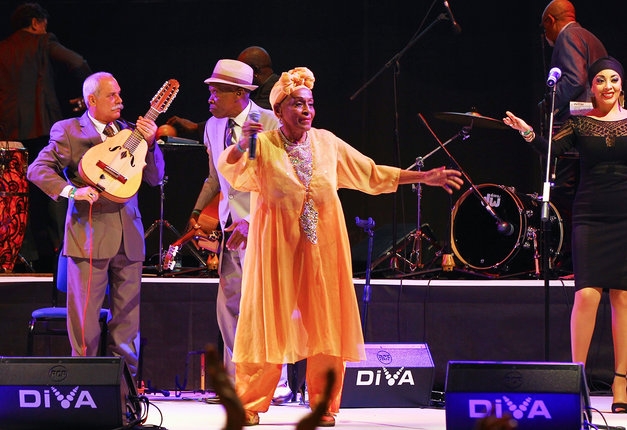One of the most revealing moments of the new documentary about the Cuban musicians known to the world as the Buena Vista Social Club happens early in the film, when Juan de Marcos González visits the house in Havana where the actual Buena Vista Social Club, a neighborhood dance hall and community center, was located before being shuttered by Cuban officials in the 1960s.
González, the Cuban musician and producer who acted as Ry Cooder’s A&R man for the original Buena Vista album, ducks under a clothesline full of washing, his graying dreadlocks brushing against a bright-colored bra. As if the curtains of a speakeasy have been parted, the surprising sight of a fully-equipped gym complete with, as González brightly notes, “very modern” machines, and patrons in mid-workout, comes into view.
As the film continues, director Lucy Walker, who started work on Buena Vista Social Club: Adiós in 2015, briefly references recent significant events in Cuba and changes in the country’s relationship with the United States in more obvious ways. A Cuban radio announcer informing listeners of Fidel Castro’s death opens the documentary, which will have its commercial release tomorrow, May 26. [It had been scheduled to premiere at Sundance last January, but it was pulled from the program at the last minute.] The film also flashes on President Obama in Cuba, and Buena Vista musicians performing at the White House.
Twenty years have gone by since the Buena Vista Social Club album brought global fame to a group of senior citizens who were quickly assembled to make a recording of traditional Cuban music in a decaying Havana studio; most of the original principals have since passed away, and the new film shows that the music – and cheering crowds – accompanied them until the end. As any Buena Vista fan knows, the story of the making of the album and its main protagonists – Ibrahim Ferrer, Compay Segundo, Omara Portuondo, Ruben González and Eliades Ochoa - was already told in a 1999 documentary directed by Wim Wenders. In addition to introducing viewers to the endearing, unsinkable musicians and their sublimely catchy and culturally significant music, that film allowed for a revealing look at the island at a time when it was still seen by Americans as a forbidden destination (and vice versa).
Wenders’ film followed the BVSC artists to New York, where they reached a crescendo performing at Carnegie Hall. The new movie wraps up in 2016, when surviving original members Omara Portuondo – a riveting presence in both films – Ochoa, Manuel "Guajiro" Mirabal, laud player Barbarito Torres and an intergenerational band said goodbye to the world’s stages on the group’s international Adiós tour, which ended with a concert in Havana. (the 86-year-old Portuondo, Ochoa and other BVSC alumni continue to perform as solo artists).
As a narrator, the English-speaking Juan de Marcos Gónzalez lends the new documentary a revisionist tone. Gónzalez’s importance in the production of the Buena Vista album was overshadowed by Ry Cooder’s celebrity after the record was released and swiftly became a phenomenon, topping Billboard’s Latin Albums and World Albums charts, and going platinum in the U.S. To date, it has sold more than 12 million copies worldwide. Wenders’ film was nominated for an Oscar.
Gónzalez, who acted as musical director of the Buena Vista project, and is also known as the leader of the Afro-Cuban Allstars, had only a bit part in that movie. In the Adiós documentary, it’s Cooder who appears fleetingly, in archival footage. A disclaimer at the end of the closing credits makes clear that Cooder did not participate in the film.
González’s protagonism in Walker’s movie offers a Cuban point of view on a project that took the Cuban officials, and even other musicians, years to warm up to. Cuban music critic Pedro de la Hoz, writing for the official newspaper Granma in August 2000, voiced a widespread opinion when he suggested that Buena Vista was a capitalist plot to profit from Cuban patrimony. He went so far as to call Cooder an expert in “finding in the Third World what the First World needs,” and to describe World Circuit Records label head Nick Gold, as a “wily fox” who had created a “solid discographic saga” with Buena Vista and its sequel albums. De la Hoz mocked Wim Wenders’ film as spinning a rags-to-riches story about “the triumph of some poor musicians hailing from a city of decrepit streets, junkyard dogs and dilapidated cars” to the streets of New York, a tale “as grotesque as Tarzan’s journey to the asphalt jungle.”
In the new film, González echoes some of that scepticism when he finds himself basking in applause on a foreign stage at yet another packed Buena Vista show.
“What do these people really know about Cuba?” González asks provocatively. “What do they know about the things we’ve been through?”
The film takes a weak stab at answering those questions as the opening credits roll. Historic snippets walk us through moments in Cuban history, and its music history. The archival clips are as visually engaging as could be expected, but ultimately amount to a short list of facts, spanning centuries, that can’t help but seem random.
BVSC: Adiós does pick up the thread of a wider historic context at times, emphasizing issues of racism and corruption in Cuba in the pre-Revolutionary period before Fidel Castro’s rise. The thorny subject of Cuban exile is raised when Portuondo expresses her obvious disapointment that her sister and former bandmate sent her young niece to Miami along with thousands of other children with the Peter Pan anti-Communist airlift in the early '60s, and soon left for the U.S. herself. At that intriguing moment in the movie, the personal becomes political. But Portuondo, who for over two decades in the global spotlight has proved herself to be a consumate diplomat, doesn’t go further with it. And, unfortunately, neither does Walker.
Using outtakes from the first movie, previously unseen footage and archival clips, Adiós re-tells the by-now familiar stories of Ferrer, González, Segundo, Portuondo, Ochoa and others in the group, and relives performances of some of their well-known songs. The documentary fleshes out individual background stories of the main artists, and adds some intimate moments to the existing Buena Vista canon, particularly shedding suggestive light on the connection between Portuondo and Ferrar.
The impish big-voiced singer Ferrar emerged as the sun of Buena Vista after he stole the show in the Wenders’ film. There’s a poignant moment in Adiós when the singer, who died at age 78 in 2005, asks himself why, after a lifetime in show business during which he never fully got his due, success arrived at an age when he was practically too old to enjoy it.
But again, Walker misses an opportunity to say more. We see Ochoa, who at the time of the recording is dressed in cheap separates, now splendid in the sharp black suit that has since become his trademark, and a well-groomed Ferrer expanding his wardrobe of newsboy caps. Ferrer went from shining shoes for money to supplement his small pension one year, to making $100,000 in album royalties and concert fees the next (according to an interview with González at the time) - and presumably much more in subsequent years. At one point in Adiós, González notes that the artists were in it for love, not money, and there’s no doubt his statement is not a mere platitude or party line. But the artists of Buena Vista Social Club kept a rigorous tour schedule, performing in some of the most prestigious theaters and at festivals around the world. The movie totally sidesteps the issue of their material wealth, and how it played within the context of a Communist Cuba where musicians’ relationships with the state, as well as ideas about being compensated for their work, were rapidly changing.
The changes in the Buena Vista artists’ lives directly paralleled, and even influenced, changes in Cuba. After the Buena Vista album took off, and the musicians were welcomed around the world, they were finally embraced at home. The first Buena Vista Social Club concert in Havana took place two years after the record’s release. By that time, the project had spurred a global interest in Cuban music that had not been seen since the 1950s; the fever was particularly high in the United States, where the embargo had kept music from the island off the radio for more than thirty years.
The musicians even had an unwitting role as statesmen. In Miami, they experienced exile politics first hand: in 1998, the Miami Beach Convention Center was evacuated when a bomb threat was called in during a concert in which Compay Segundo was performing. Afterward, when the audience was allowed back into the hall, Segundo, who was then 90 years old, returned to the stage, announced drolly, "Okay, so you had a rest," and played on. At one point he shouted "Music doesn't bother anybody. Music is music!" In 1999, Ferrer andRuben González canceled a show in Miami that was besieged by advance exile protests. But overall, Buena Vista’s pre-Revolutionary sound softened Cuban exile audiences’ opposition to music from the island, and primed them to gradually accept contemporary groups coming from Cuba. Today, a concert by a Cuban musician in Miami is a common occurrence. And a Cuban artist making it to the Billboard Latin charts is no longer remarkable. In 1997, when the Buena Vista Social Club album took the No. 1 slot, it was a historic event.
In addition to solo albums by the Buena Vista artists, the market became flooded with vintage Cuban music and Buena Vista wannabes. Foreign producers mined the archives of Cuba’s state label Egrem to create compilations of old Cuban music, and Cuban music officials realized the extent of the value in their vaults. The allure of Buena Vista also called out to tourists at a time when the Cuban government had just begun to increase their efforts to promote Cuba as a destination in the wake of the collapse of the Soviet Union and a period of economic emergency in Cuba.
None of this is addressed in Adiós. And there’s no follow up to that compelling early scene when González reveals the Buena Vista Social Club gymnasium. There is some reference to the pre-Revolutionary segregation that created such social clubs, but no mention of the fact that interest in the album led to a reunion of the original members of the actual club in 1999, where they exchanged photos of the great Benny More performing there. Later, in 2007, a short-lived revival of the club was documented by German director Carsten Moller in Second Look: Buena Vista Social Club, a downbeat portrait of frustrated Havana residents that contrasted with the euphoric story of the Buena Vista Social Club.
Adiós is a sentimental journey that, despite some attempts to cover new territory, ultimately doesn’t stray far from that original Buena Vista story line. Curiously, it doesn’t even detour to meet the accomplished and appealing younger artists who joined the line-up over the years; they make only cameo appearances in the film. Certainly their stories, while perhaps lacking the fairy-tale appeal of their now more famous predecessors, are equally as interesting, and could have provided the perfect vehicle for taking the story forward.
Walker’s documentary is more of an encore than a sequel. But it does serve to demonstrate, 20 years on, that the Buena Vista Social Club was not a mere novelty, but a gifted group of professional musicians who collectively achieved one of the most spectacular second acts in music history, and revived interest in Cuban music in the process. The best thing about Adiós is that it will give diehard fans a chance to see them one more time.








